Stock Market Trends, Remember the Past Remember the Wolf
Stock-Markets / Stock Markets 2011 Apr 09, 2011 - 01:41 AM GMTBy: Doug_Wakefield
 “The so-called ‘surprises’ of history have emerged not because other countries did not have information, but because they refused to believe it.” (pg 919) Carroll Quigley, Tragedy and Hope: A History of the World in Our Time (1966)
“The so-called ‘surprises’ of history have emerged not because other countries did not have information, but because they refused to believe it.” (pg 919) Carroll Quigley, Tragedy and Hope: A History of the World in Our Time (1966)
Any serious student of financial markets studies the relationship between credit, markets, and crowds. In addition, they are always fascinated by mathematical patterns that unfold in markets; math being used in our markets today more than any time in human history.
There is ample evidence of the relationship between credit and crowds with famous bubbles going back over 400 years of history; two of which we have all lived through in the last 15 years, and one in which we are living through right now. Yet it would appear that millions of investors and advisors still seem to place their trust in the theory that the markets are telling them “ the higher markets go, the LESS likely of a severe decline”. It still remains too painful to face the question “Why have I lived though two massive market collapses in less than 11 years?”
If you are reading this article, you are an individual who understands the value of learning. You probably are not swept up in investment entertainment and positive advertisements of “you are in control”, but grasp the reality that the last decade of enormous swings in global markets has turned investors into speculators in a giant global casino. Since “the house” requires more and more intervention into markets and larger quantities of debt that will never be repaid, you are constantly seeking to get ahead of the next big change.
With headlines like the one below, released just days before an annual meeting of global “experts” in January, I can’t think of a better time to be asking questions.
World Needs $100 Trillion More Credit, Says World Economic Forum
UK Telegraph, Jan 18 ‘11
Three Questions
Question 1 – Are there any periods of history that our industrious central bankers could examine in an attempt to grasp the direct relationship between credit and speculation?
Let’s start with the late 1600s:
“The course and features of the 1690s stock market boom are clearly recognizable to any operator in the contemporary financial markets, even though the London stock market at that date was barely a decade old and remained fairly primitive…. Since the time of the Civil War (1642-51), English goldsmiths had taken on the functions of bankers, making loans and creating a market for merchant’s bills of exchange (credit notes). By the 1690s, the total value of bills of exchange in circulation was believed to exceed the currency of the kingdom…Credit was in constant flux, elusive, independent, and uncontrollable…Credit was the Siamese twin of speculation; they were born at the same time and exhibited the same nature; inextricably linked they could never be totally separated.” [Devil Take the Hindmost: A History of Financial Speculation (1999) Edward Chancellor, pp 31-2]
…the 1700s:
“On May 5, 1716, the Banque Generale was founded with 6 million livres in capital and was assured success from the beginning….For the first time in modern history, paper money was being introduced and officially sanctioned by a government…The rue Quincampoix was transformed overnight into an open air trading pit. Rents along the street shot up. Enterprising shopkeepers were renting out their storefronts as exorbitant rates to equally enterprising people who set themselves up as impromptu stockbrokers. At roughly the same time, the Duc d’ Orleans (head for France’s finances) was beginning to notice that the paper banknotes acted like an elixir on the public….Prince Phillip II must have thought: People have gained confidence in the paper banknotes; the notes appear to have provided a convenient way for the government to borrow (despite the outstanding debt still on the books); the paper money both traded at a premium and appeared to be reviving France’s stalled economy. Why not print more?… [B] y the end of 1719, [the Duc] had issued 1,000 million new banknotes, effectively increasing the money supply by 16 times its previous amount…For the first time in France’s history, the middle class was getting in on the act. It looked like a new era….After a short correction to 4,800 in late September the shares [of the Mississippi Company] broke through all resistance levels and skyrocketed higher and higher – 6,463 on October 26, 7,463 on November 18, and 8,975 just a day later!… Ordinary folks, buying shares on margin, made unimaginable fortunes. Owing to the ‘success’ of his scheme, by 1720 John Law [advisor to the Duc] became the richest man on earth.
Alas, all things get corrected – even man’s reputation….In the end, nothing could save Law’s company or the worthless scrip issued by the Banque Royale. The collapse of the Mississippi Company in 1720 ruined thousands of middle –upper class French citizens and destabilized the French currency.” [Financial Reckoning Day: Surviving the Soft Depression of the 21st Century (2003), Bill Bonner and Addison Wiggins, pp 78-85]
Let’s jump to the roaring 1920s:
“World War I marked a great divide in American credit. As we have noticed before (and will have reason to observe again), the wheels of debt rarely grind at one speed for very long…..At the outbreak of the war, the Federal Reserve System got into the business [Dec 23 ‘1913] of suppressing interest rates…Thus, low interest rates stimulated the expansion of lending, and ultimately, the rise in prices….All the while, the riot of luxury and extravagance (the inflationary boom) continued. National City Bank [founded in 1845, acquired by PNC Financial Services in Oct ‘08] turned on the spigots in Cuba, and small town banks financed the bull market in Iowa farmland…At the start of the 1920s, the Strauss [financer of real estate bonds] approach was, in fact, conservative. By the end of the decade, it was risky (and fraudulent too). The evolution was telling in the 1920s, and it anticipated the 1980s. In each decade, the terms and conditions of lending became progressively easier with the passage of years. Auto finance helps to illustrate the tendencies. To start with, cars were financed for a year and with a down payment of one-third of the purchase price. However, as Professor Edwin R.A. Seligman noted in 1927: ‘With the growing competition between dealers to increase the volume of their sales, the minimum cash payment was gradually reduced and the maximum period of installments was lengthened.’ …[I] n the gathering prosperity of the 1920s, lending standards generally softened. They were relaxed in the markets for foreign government bonds, corporate bonds, and urban mortgages” [Money of the Mind: Borrowing and Lending in America from the Civil War to Michael Milken (1992) James Grant, pg 145-163]
Question 2 – What happens AFTER a period of runaway speculation, built on a foundation of large sums of cheap credit entering financial markets?
“A crash is a collapse of the prices of assets, or perhaps the failure of an important firm or bank. A panic…may occur in asset markets or involve a rush from less to more liquid assets. Financial crisis may involve one or both, and in any order. The collapse of South Sea stock [London, 1720] and the Sword Blade Bank almost brought down the Bank of England. The 1929 crash and panic in the New York stock market spread liquidation to other asset markets, such as commodities, and seized up credit to strike a hard blow at output. …
The system is one of positive feedback. A fall in prices reduces the value of collateral and induces banks to call loans or refuse new ones, causing mercantile houses to sell commodities, households to sell securities, industry to postpone borrowing, and prices to fall still further. Further decline in collateral lends to more liquidation. If firms fail, bank loans go bad, and then banks fail. As banks fail, depositors withdraw their money (this was particularly true in the days before deposit insurance). Deposit withdrawals require more loans to be called, more securities to be sold. Merchant houses, industrial firms, investors, banks in need of ready cash – all sell off their worst securities if they can, their best if they have to.”
[Manias, Panics, and Crashes: A History of Financial Crises, Fourth Edition (2000), Charles P. Kindleberger, pp 105-106]
While I could expound for several hundred pages on the history of cheap credit and speculation, I had rather jump straight to a few charts of our present juncture and bring us up to current events.
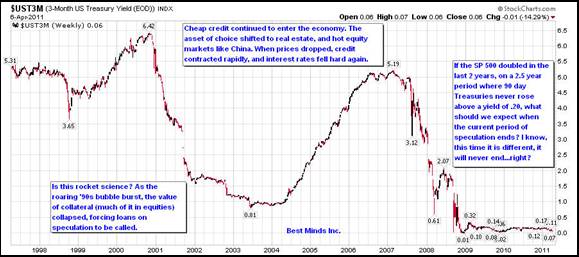
[view at 150%]
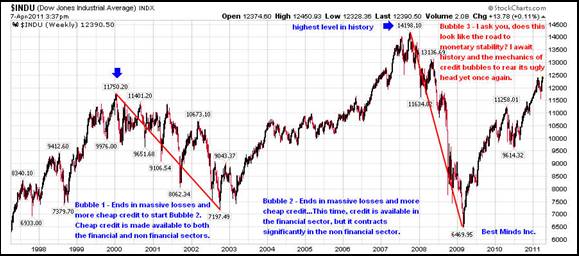
Question 3 – Since our markets are much more sophisticated today, and we have a “lender of last resort”, the relationship between credit and market prices doesn’t work the same way, right?
The following is a look at the start of the global credit crisis that began in the summer of 2007. You be the judge of the boys at mission control appear to have learned anything from history:
“A couple of the internal hedge funds at Bear Sterns had undergone explosive growth, based on overleveraging (modern lingo for the ‘uncontrollable credit’ that Chancellor refers to in the 1690s) subprime and other risky securities, which were spun into high-quality assets and blessed by the various rating agencies. Once demand dried up for these types of securities, their values plummeted. This meant that their value as collateral for borrowing also shrunk. Creditors started to ask for more collateral to be posted to make up for this difference. At the same time, investors were pulling out. The only way to come up with extra money to post as collateral was to sell the assets at bargain prices, which decreased the value of the funds further.” [It Takes a Pillage: Behind the Bailouts, Bonuses, and Backroom Deals from Washington to Wall Street (2009) Nomi Pris, pp 12]
Pictures from the Gallery of Bubble Collapses
Today, I believe many individuals assume that we are headed in the wrong direction, but have convinced themselves that the “more cheap credit, higher market prices” theory will not lead to anymore severe declines…at least not in the near future. We are not looking for an END to another bubble, solely counting on low interest rates, cheap credit, and even market manipulation to assist the growth of our own wealth. I ask you, is there something wrong with this picture? Are there any modern pictures at historical turning points that would warn us how fast things can change?
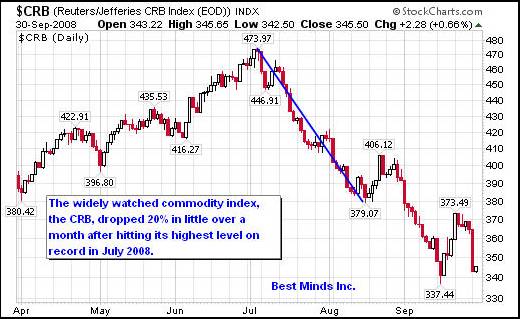
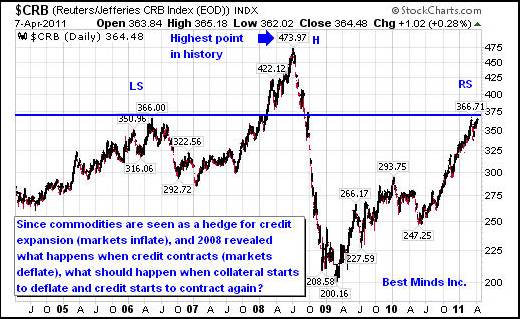
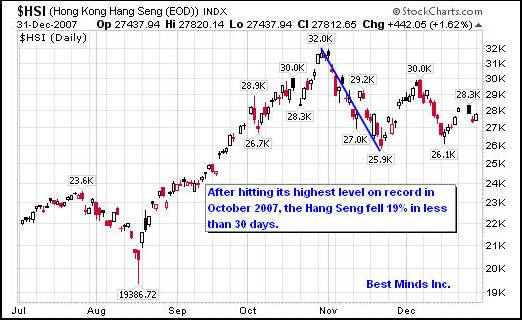
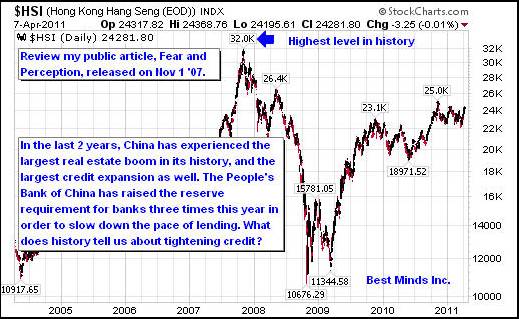
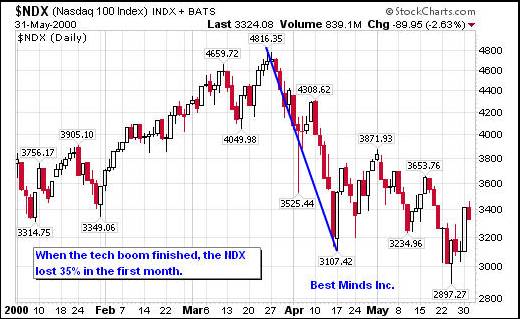
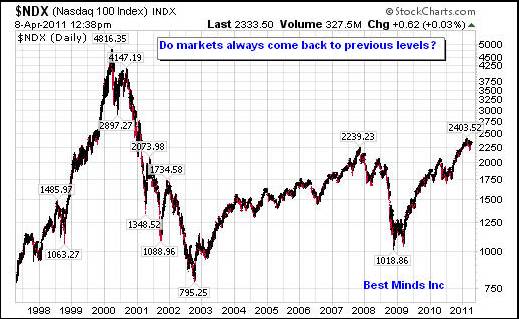
If you have read any of my public articles since 2005, you know that my calls for sanity in the nefarious credit explosion, bust, and subsequent explosion that has impacted our financial markets (not the private sector of the economy which still contracts from its 2007 turning point), make me look today like the boy who cried wolf. However, I do believe there was another story about a wolf and innocent investor (aka Red Riding Hood) who just refused to believe that the wolf had set her up for harm again.
The following can be found in the March 29, 2011 WSJ article, Unreported Soros Event Aims to Remake Entire Global Economy:
“Two years ago, George Soros said he wanted to reorganize the entire global economic system. In two short weeks, he is going to start – and no one seems to have noticed.
On April 8, a group he’s funded with $50 million is holding a major economic conference and Soros’s goal for such an event is to “establish new international rules” and “ reform the currency system.” It’s all according to a plan laid out in a Nov. 4, 2009, Soros op-ed calling for “a grand bargain that rearranges the entire financial order?”
And if we go back just 29 months ago, one can learn that Soros, an “enormously successful speculator”, also promoted this same issue during the eye of the 2008 meltdown storm. The following comments can be found in the Nov 2008 issue of The Investor’s Mind: The Power of the Few, which quoted an October 28, ’08 article in the Financial Times, America Must Lead a Rescue of Emerging Economies:
“The IMF is discussing a new credit facility for countries at the periphery,
in contrast to the conditional credit lines that were never used because the
conditions attached to them were too onerous. The new facility would carry no conditions and no stigma for countries following sound macroeconomic policies. In addition, the IMF stands ready to extend conditional credit to countries that are less well qualified.” (Italics mine)
“Unfortunately the authorities are always lagging behind events; that is why the financial crisis is spinning out of control. Already it has enveloped the Gulf countries, and Saudi Arabia and Abu Dhabi may be too concerned with their own region to contribute to a global fund. It is time to start thinking about creating special drawing rights or some other form of international reserves on a large scale, but that is subject to American veto.”
Remember, the world is not coming to an end, just the world as we have grown to know it. When changes are occurring at the foundational level, we must never forget that what we are watching on the surface may not be as real as we think and feel at that moment in time.
Big Lie: A deliberate gross distortion of the truth used specifically as a propaganda tactic, Merriam-Webster.com
Due to the levels we have reached in this mania, and the manipulation we have watched unfold in the last 2 years, I have decided to place my entire research report, Riders on the Storm: Short Selling in Contrary Winds (2006), on the web. The document can be downloaded for free by clicking this link, or scrolling down to Recent Updates on the Best Minds Inc homepage. 2011 is setting up to require a totally different view of strategies than the last 2 years, and during this time of enormous deception will require examining a wide range of markets through a variety of lenses.
If you are interested in our most comprehensive research, consider a subscription to
The Investor's Mind: Anticipating Trends through the Lens of History.
Doug Wakefield
President
Best Minds Inc. , A Registered Investment Advisor
3010 LBJ Freeway
Suite 950
Dallas , Texas 75234
doug@bestmindsinc.com
phone - (972) 488 -3080
alt - (800) 488 -2084
fax - (972) 488 -3079
Copyright © 2005-2010 Best Minds Inc.
Best Minds, Inc is a registered investment advisor that looks to the best minds in the world of finance and economics to seek a direction for our clients. To be a true advocate to our clients, we have found it necessary to go well beyond the norms in financial planning today. We are avid readers. In our study of the markets, we research general history, financial and economic history, fundamental and technical analysis, and mass and individual psychology.
Disclaimer: Nothing in this communiqué should be construed as advice to buy, sell, hold, or sell short. The safest action is to constantly increase one's knowledge of the money game. To accept the conventional wisdom about the world of money, without a thorough examination of how that "wisdom" has stood over time, is to take unnecessary risk. Best Minds, Inc. seeks advice from a wide variety of individuals, and at any time may or may not agree with those individual's advice. Challenging one's thinking is the only way to come to firm conclusions.
Doug Wakefield Archive |
© 2005-2022 http://www.MarketOracle.co.uk - The Market Oracle is a FREE Daily Financial Markets Analysis & Forecasting online publication.



